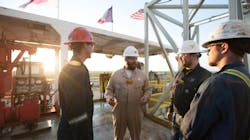Chevron Corp. raised its 2022 production growth forecast for its Permian basin operations to 15% from 10% after a first quarter in which Chairman and Chief Executive Officer Mike Wirth said the company continued its recovery from 2020’s COVID-19 shock.
Chevron, San Ramon, Calif., posted a net profit of nearly $6.3 billion in the first 3 months of this year compared to $1.4 billion in early 2021. Revenues rose to $54.4 billion from $32.0 billion and operating income jumped to more than $9 billion from $2.2 billion. Globally, Chevron’s net oil equivalent production in the first quarter was nearly 3.1 MMboe/d, which was down slightly year over year because of a drop in international output, while net natural gas production increased about 2% to 7.9 MMcfd.
The company’s upstream operations produced 1.18 MMboe/d in the first quarter, which was an increase of 10% from early 2021, when Winter Storm Uri hampered production. Net liquids and natural gas production rose in line with the broader number. Capex in the quarter rose to $2.8 billion from $2.5 billion a year earlier, with US upstream operations receiving $1.3 billion versus $1.05 billion in the year-prior period.
Permian basin unconventional production grew to a record 692,000 boe/d in the quarter, an increase of 14% from 2021’s average, and Wirth and his team expect that number to grow to 700,000-750,000 boe/d for all of 2022. Wirth told analysts and investors on an Apr. 29 conference call the increases haven’t been and won’t be the result of a big step up in Chevron’s programs or the addition of rigs. Instead, they’re primarily the result of working off an unusually large inventory of drilled-but-uncompleted (DUC) wells that grew during the spring and summer of 2020.
“It’s all a function of getting the machine running again,” Wirth said, adding that Chevron teams also are building efficiency improvements into their work.
Over the medium term, Chevron is forecasting production from the Permian’s Midland and Delaware basins will grow to about 1 MMboe/d by 2025 before plateauing near 1.5 MMboe/d around 2030. The company plans to invest about $4 billion/year in the region—about a fifth of total capex—and thinks it will generate more than $4 billion in free cash flow from its Permian business in 2026.
Other items from Chevron’s conference call include:
- Chief Financial Officer Pierre Breber said the company is seeing more labor and equipment cost pressures in the Permian basin but that international operations are showing “not very much at all” on that front.
- Wirth said that while Chevron plans to close on its acquisitions of Renewable Energy Group Inc. and its renewable feedstocks joint venture with Bunge Ltd. in the coming months, investors shouldn’t look for the company to make large acquisitions in the near future: “We like our portfolio where it sits today and really don’t feel there’s a hole to be filled.”
- Asked for his current take on the overall oil and gas markets, Wirth said he expects geopolitical tensions and supply-demand imbalances to last for a while. He also noted that supply is often relatively slow to respond to demand increases such as the bounce back from COVID-19 and said many in the industry are being careful not to overextend capex.
“One of lessons of history is that, just as the bad times don’t last forever, neither do the times when prices are strong,” he said.
Shares of Chevron (Ticker: CVX) were down nearly 3% to about $157.40 in afternoon trading Apr. 29. Year to date, shares have risen about 30%, pushing the company’s market capitalization to about $310 billion.
About the Author
Geert De Lombaerde
Senior Editor
A native of Belgium, Geert De Lombaerde has more than two decades of business journalism experience and writes about markets and economic trends for Endeavor Business Media publications Healthcare Innovation, IndustryWeek, FleetOwner, Oil & Gas Journal and T&D World. With a degree in journalism from the University of Missouri, he began his reporting career at the Business Courier in Cincinnati and later was managing editor and editor of the Nashville Business Journal. Most recently, he oversaw the online and print products of the Nashville Post and reported primarily on Middle Tennessee’s finance sector as well as many of its publicly traded companies.

